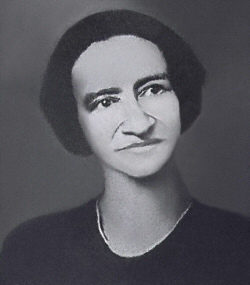Drusilla Dunjee Houston was a prolific, but now forgotten, African-American woman writer of the American West. She was a skilled journalist, Racial Uplift matriarch, and community builder in early Oklahoma (Brooks-Bertram 2002, xlii). We learn from Derek Allen’s 1936 Federal Writers Project report that she was also an accomplished musician who studied at the Northwestern Conservatory of Music in Minnesota where she trained in classical piano. In addition to her community work, Houston engaged in pioneering African American scholarship in which she crafted a series of historical texts on ancient African history, most notably, what she called “The Wonderful Ethiopians.” Her first book in the series, Wonderful Ethiopians of the Ancient Cushite Empires Book 1: Nations of the Cushite Empire, Marvelous Facts from Authentic Records, was self-published in 1926 and was followed by at least six others, all written somewhere between 1915 and 1926 (Brooks-Bertram 2002, 69). Regrettably, four volumes in the series appear lost, but Volume II subtitled Origin of Civilization from the Cushites was discovered in 1998 and published again in 2007. Houston was the daughter of Rev. John William Dungy, famed church builder who started the American Baptist Home Missionary Society. In addition to writing historical texts, Houston worked as a contributing editor for the Oklahoma Black Dispatch, a newspaper she ran with her brother civil rights activist Roscoe Conkling Dunjee who founded the Oklahoma branch of the National Association for the Advancement of Colored People. Between 1914 and her death in 1941 Houston wrote nearly 3,000 editorials on subjects including the Tulsa Race Riot, the Houston Riots of 1917, and the East St. Louis Massacre, one example of which is a 1922 article in the Oklahoma Black Dispatch on caring for Black children.
Apparently unknown to anyone at the time, as early as 1902 Houston also began to write a refutation of Thomas Dixon’s works. [Ed: If she began in 1902 she may have been challenging The Leopard’s Spots, the first novel in Dixon’s reconstruction trilogy, the second of which was the 1905 The Clansman. Dixon’s play “The Clansman,” dating from 1905, was a based on both of these novels, and began its long run in the south that year. See Gillespie and Hall, 7, 10.] Looking back, it is now clear that Drusilla Dunjee Houston was also taking on the notorious motion picture based on Dixon’s play and novels, D.W. Griffith’s The Birth of a Nation (1915). It may be that Houston was the first and only African American—male or female—to write a blow by blow refutation of Birth of a Nation, a challenge that she hoped would become, in her words, a “flashing photo play.” We see her hopes in the closing statement of her prologue: “This story told by a powerful grapho-phone with the pictures flashing might be something new in moving pictures.”
In the foreword to one of the volumes of the 2007 Oklahoma Centennial Project the editors describe Houston as having “railed against the lynching of black men and women in Oklahoma and throughout the country” (Nevergold and Brooks-Bertram). Here, where Dunjee Houston’s screenplay is brought to light for the first time in recent years, the editors explain that her eloquent attack on lynching was written in verse and variously named: “Spirit of the Old South: The Maddened Mob” and “The Maddened Mob-America’s Shame,” (Nevergold and Brooks-Bertram, 15). But the fifty-eight page elegy, written in screenplay format was never produced as a motion picture. Drusilla Dunjee Houston explains what happened to “Spirit of the Old South: The Maddened Mob” in the prologue to it: “The photoplay lay for long years, pushed aside by executive duties and also because the author knew that American literature was only catering to Topsy, Uncle Tom, and slap-stick minstrel Negro types. This screenplay represents an early attempt to refute not just the racist themes in Birth of a Nation but also an attack on all of Thomas Dixon’s novels and plays that contributed to the film, Birth of a Nation.”
In 1933, she broke her silence about the screenplay she had begun writing more than two decades earlier, motivated at the time by the need to refute the ugly misrepresentation of African Americans in Birth of a Nation. [Ed: The film continued to be screened into the 1930s. See Fleezner-Marzac 1980.] Fearing threats to her life and danger to her family because the content violated the Sedition and Espionage Acts and because the Ku Klux Klan was active in Oklahoma at the time, she had kept the play a secret. She finally wrote to a friend in 1933: “For 23 years, I have had lying unpublished a motion picture play almost as sensational as ‘The Clansman,’ but I did not dare to offer it to the literary public because the American white man utterly refuses to recognize such a character as my heroine, though the race has many of her counterparts” (Brooks-Bertram 2002). In 1938, still furious with the widespread support for Dixon’s works, especially the The Birth of a Nation, Houston described in the Oklahoma Black Dispatch what Black women had to do to challenge the film and the play on which it was based. Since, as she wrote, the historical truth still needed to be brought to the attention of the nation, “The Negro must produce plays to answer and undo the work of ‘The Clansman.'”

